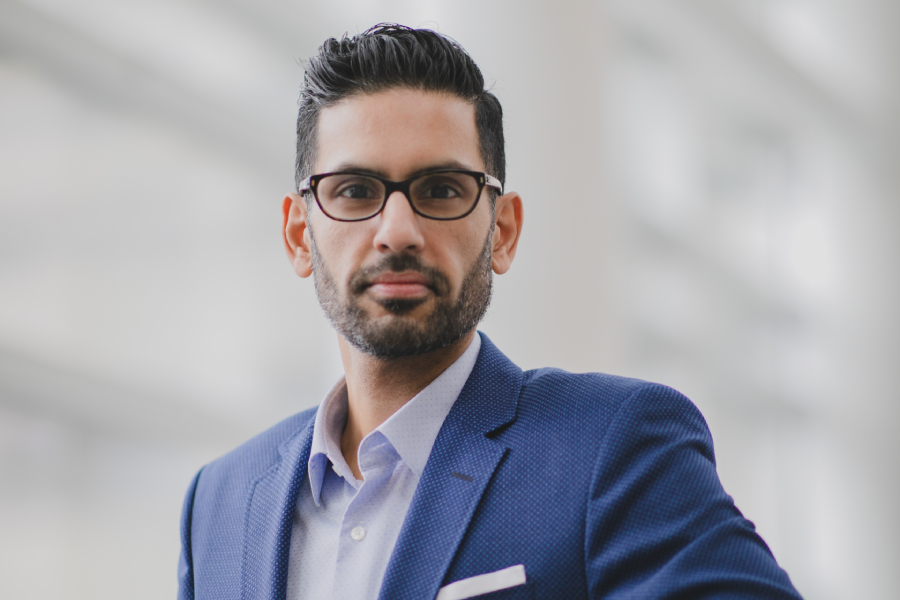
The COVID-19 pandemic has drastically changed every field in Canada, but none as much as health care.
For Dr. Fayez Quereshy, it’s been a challenging two-year journey, but in some ways also a gratifying one.
“It’s been such an unbelievable transition in so many ways,” says the Clinical Vice President of University Health Network (UHN) and surgical oncologist in UHN’s Sprott Department of Surgery.
No one would call a massive, global public health crisis a positive thing, but there are some silver linings. Almost overnight, major and necessary changes were made in health care that otherwise would have taken decades. Virtual care has become crucial, and hospitals are prepared for emergencies like never before.
“Maybe I’m a glass-half-full kind of person, but in every challenge or crisis there’s always opportunity,” Dr. Quereshy says. “We’ve been able to face a wicked problem and adapt quickly, and that speaks to the creativity and ingenuity of our team members at UHN. We were able to recognize a common problem and come together for a common purpose. And some of the lessons we’ve learned are totally applicable to the future.”
Hospital staff regularly do exercises for a “Code Orange” – essentially a simulation of a mass casualty event like a terror attack or natural disaster in which hospitals are overrun. They determine how to operate and kick into emergency mode. Two years ago, before the first recorded COVID case, the city of Toronto did one as a large-scale city-wide exercise. It seemed big at the time, but the scope was actually just a few city blocks.
“COVID has shown that scale can expand to the entire world,” Dr. Quereshy says. “So how can we prepare differently?”
Two years later, although we’re still in the midst of the pandemic, UHN is much more prepared.
Thinking back to the early days of COVID, Dr. Quereshy remembers how little we initially knew about the virus. Every patient coming in was treated as if they were a potential positive case, and risk assessment became extremely important.
Media reported that the government gave a directive to “cancel all elective surgeries,” but Dr. Quereshy says that language painted the wrong picture. He remembers waking up in the middle of the night worrying about patients having procedures delayed.
“We don’t do elective surgery at UHN,” he says. “Everyone who gets surgery here, whether it’s cancer surgery or even hip or knee replacements, that’s not elective. It’s essential care that had to be deferred. And those were difficult choices that had to be made.”
Those choices became especially difficult when it came to patients living with cancer. In an environment with limited resources, how do you prioritize who needs urgent care and who can delay their procedures or use different kinds of treatments? And how do you do it in a compassionate and equitable way?
UHN quickly gathered a team of doctors, nurses, technicians, bioethicists and patients to develop an ethical framework to address this issue. The building blocks for that framework existed before the pandemic, but the urgency made them put it into action. And now that scaffolding to make those tough decisions is established long term.
Tough decisions often also means tough conversations. The face-to-face interactions, the holding of a hand and just sitting side-by-side is a major component of oncological work. Shifting these essential elements to the virtual world has reinforced how important the human connection is.
Communication is key. Dr. Quereshy and his team now call each patient on the waitlist on a weekly basis, constantly reevaluating their circumstances and probing them about subtle changes in their symptoms. If symptoms are progressing, the team will assess whether surgery is urgently needed.
The major shift towards virtual care has been helpful in saving long transportation trips for older patients or patients with mobility issues. It also lets you stay in more constant communication with patients and increases the number of people you can help each day.
“It would have taken a generation to adapt into the tools we’re using now, that got implemented in a matter of weeks and months,” Dr. Quereshy says. “Virtual care is such an amazing tool.”
It changes how you can talk with a patient, and Dr. Quereshy has become an expert in reading faces and discerning vocal tone.
“It changes the dynamic in how you interact when virtually you can only see a person from the face up, or if they’re in person and wearing a mask, from the eyes up,” he says. “Being able to read their reactions is so critical. I can see if someone’s smiling through their eyes. I’ve learned to listen carefully to their tone of voice in addition to the words they’re saying. You have to manage the whole patient, not just the disease.”
Going virtual has also created a more collaborative team approach to health care. Historically, providers tend to work in silos with one practitioner to one patient. Now, surgeons with similar skill sets have come together to help patients facing similar circumstances – a process that abbreviates wait times significantly.
“It’s a total shift in culture,” he says. “More than ever before, the patient is front and centre.
“We’ve learned that a public health crisis of this magnitude is not an impossibility. Now we have the know-how to be prepared for whatever comes our way.”
Give patients a reason to celebrate this holiday season. Give the gift of hope.
Donate to UHN Foundation today: UHNfoundation.ca/holiday
Discover more about the latest from UHN Foundation here.












